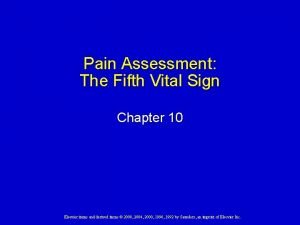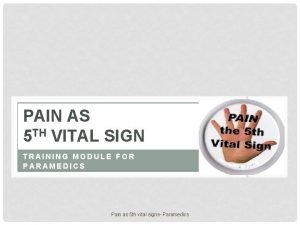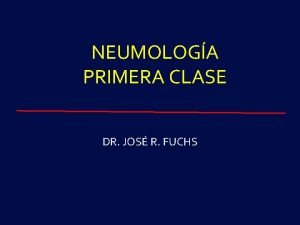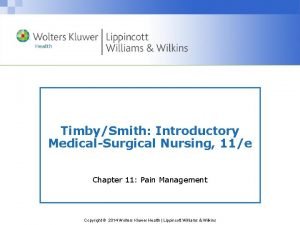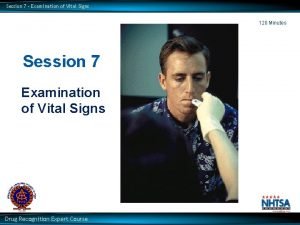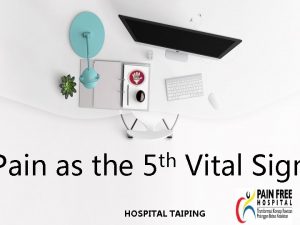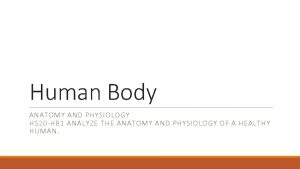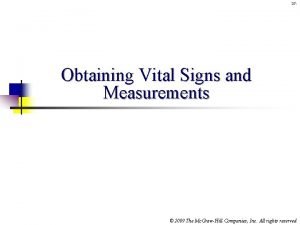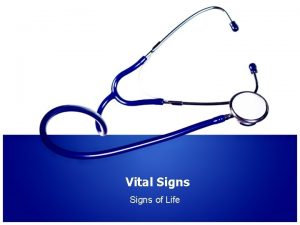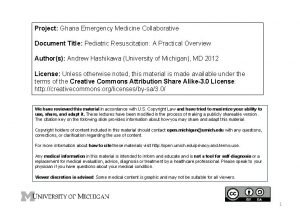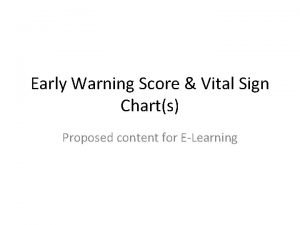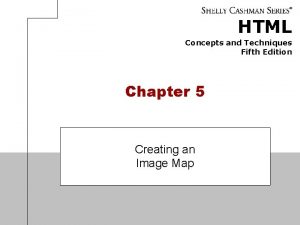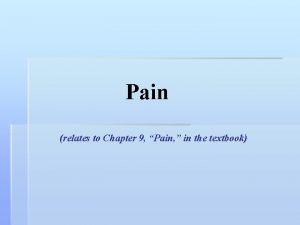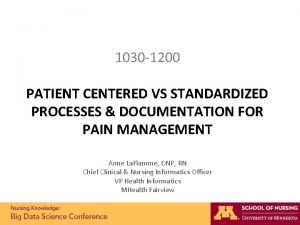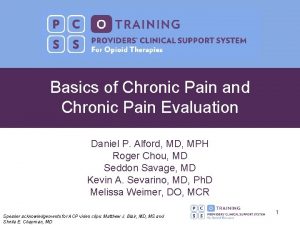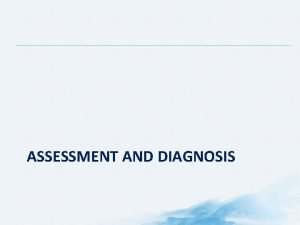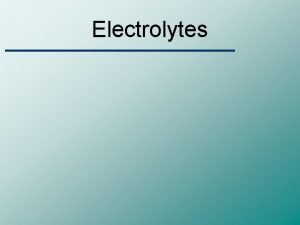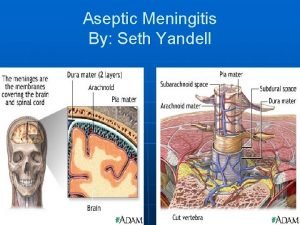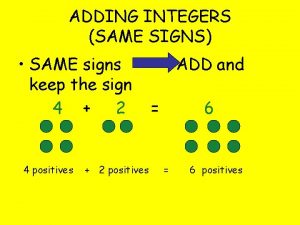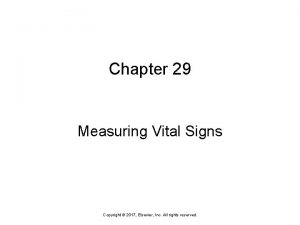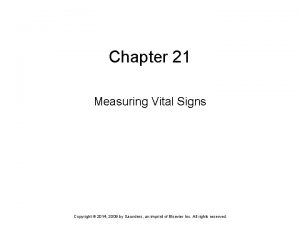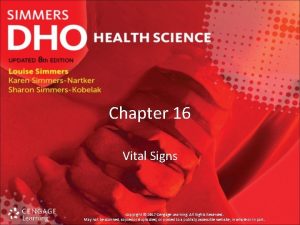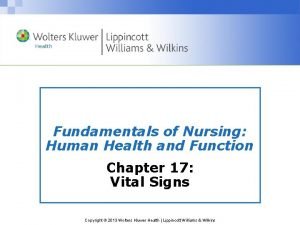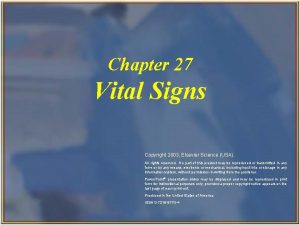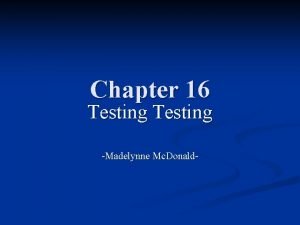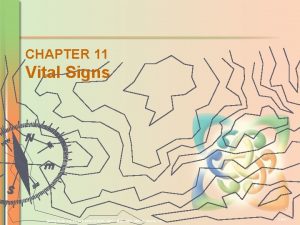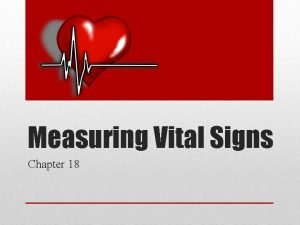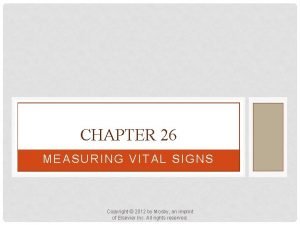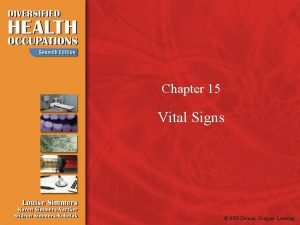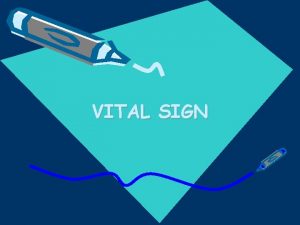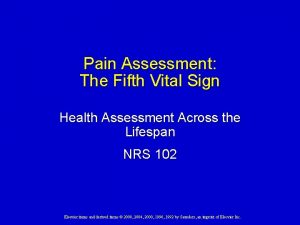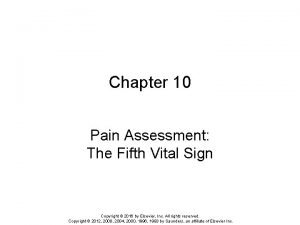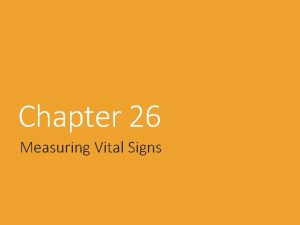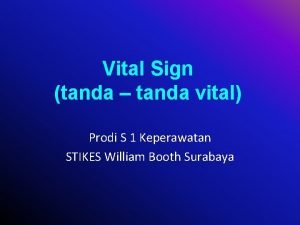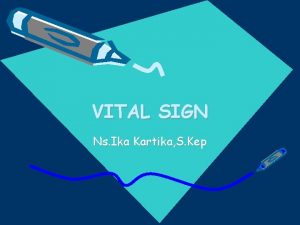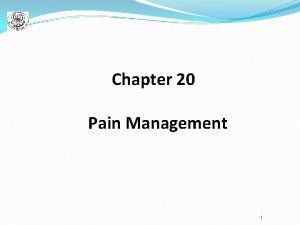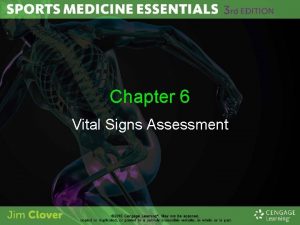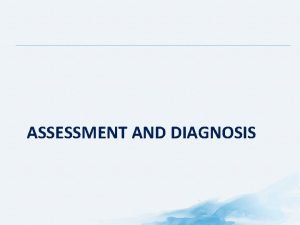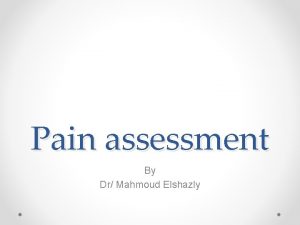Pain Assessment The Fifth Vital Sign Chapter 10






























































- Slides: 62

Pain Assessment: The Fifth Vital Sign Chapter 10 Elsevier items and derived items © 2012, 2008, 2004, 2000, 1996, 1992 by Saunders, an imprint of Elsevier Inc.

Chapter 10: Pain Assessment: The Fifth Vital Sign Pain is a highly complex and subjective experience that originates from the central nervous system (CNS), the peripheral nervous system (PNS), or both Elsevier items and derived items © 2012, 2008, 2004, 2000, 1996, 1992 by Saunders, an imprint of Elsevier Inc. Slide 10 -2

Chapter 10: Pain Assessment: The Fifth Vital Sign Structure and Function Nociceptors: specialized nerve endings designed to detect painful sensations Ø Transmit sensations to central nervous system • Located within skin; connective tissue; muscle; and thoracic, abdominal, and pelvic viscera • These nociceptors can be stimulated directly by trauma or injury or secondarily by chemical mediators released from site of tissue damage • Nociceptors carry pain signal to central nervous system by two primary sensory (afferent) fibers: Aδ and C fibers Elsevier items and derived items © 2012, 2008, 2004, 2000, 1996, 1992 by Saunders, an imprint of Elsevier Inc. Slide 10 -3

Chapter 10: Pain Assessment: The Fifth Vital Sign Neuroanatomic pathways Elsevier items and derived items © 2012, 2008, 2004, 2000, 1996, 1992 by Saunders, an imprint of Elsevier Inc. Slide 10 -4

Chapter 10: Pain Assessment: The Fifth Vital Sign Structure and Function (cont. ) Nociceptors: specialized nerve endings designed to detect painful sensations (cont. ) • Aδ fibers are myelinated and larger in diameter, and they • • • transmit pain signal rapidly to CNS; localized, short-term, and sharp sensations result from Aδ fiber stimulation In contrast, C fibers are unmyelinated and smaller, and transmit signal more slowly; sensations diffuse and aching, and they persist after initial injury Peripheral sensory Aδ and C fibers enter spinal cord by posterior nerve roots within dorsal horn by tract of Lissauer Fibers synapse with interneurons located within a specified area of cord called substantia gelatinosa Elsevier items and derived items © 2012, 2008, 2004, 2000, 1996, 1992 by Saunders, an imprint of Elsevier Inc. Slide 10 -5

Chapter 10: Pain Assessment: The Fifth Vital Sign Structure and Function (cont. ) Nociceptors: specialized nerve endings designed to detect painful sensations (cont. ) • A cross section shows that gray matter of the spinal cord divided into series of consecutively numbered laminae (layers of nerve cells) • Substantia gelatinosa is lamina II, which receives sensory input from various areas of body • Pain signals then cross over to other side of spinal cord and ascend to brain by anterolateral spinothalamic tract Elsevier items and derived items © 2012, 2008, 2004, 2000, 1996, 1992 by Saunders, an imprint of Elsevier Inc. Slide 10 -6

Chapter 10: Pain Assessment: The Fifth Vital Sign Nociception Elsevier items and derived items © 2012, 2008, 2004, 2000, 1996, 1992 by Saunders, an imprint of Elsevier Inc. Slide 10 -7

Chapter 10: Pain Assessment: The Fifth Vital Sign Structure and Function (cont. ) Nociception Ø Important to understand pain occurs on a cellular level • Only then can you appreciate patient’s report of painful sensations that develop after initial site of injury heals • Nociception is term used to describe how noxious stimuli are perceived as pain • Nociception can be divided into four phases Transduction Transmission Perception Modulation Elsevier items and derived items © 2012, 2008, 2004, 2000, 1996, 1992 by Saunders, an imprint of Elsevier Inc. Slide 10 -8

Chapter 10: Pain Assessment: The Fifth Vital Sign Structure and Function (cont. ) Nociception (cont. ) • Initially, first phase of transduction occurs when a • • noxious stimulus in form of traumatic or chemical injury, burn, incision, or tumor takes place in periphery Injured tissues then release a variety of chemicals, including substance P, histamine, prostaglandins, serotonin, and bradykinin These are neurotransmitters that propagate pain message, or action potential, along sensory afferent nerve fibers to spinal cord These fibers terminate in dorsal horn of spinal cord In second phase, known as transmission, pain impulse moves from level of spinal cord to brain Elsevier items and derived items © 2012, 2008, 2004, 2000, 1996, 1992 by Saunders, an imprint of Elsevier Inc. Slide 10 -9

Chapter 10: Pain Assessment: The Fifth Vital Sign Structure and Function (cont. ) Nociception (cont. ) • At synaptic cleft are opioid receptors that can block this • • pain signaling with endogenous or exogenous opioids However, if uninterrupted, pain impulse moves to brain via various ascending fibers within spinothalamic tract to brain stem and thalamus Once pain impulse moves through thalamus, the message is dispersed to higher cortical areas via mechanisms that are not clearly understood at this time In third phase, perception indicates conscious awareness of painful sensation Cortical structures such as limbic system account for emotional response to pain Elsevier items and derived items © 2012, 2008, 2004, 2000, 1996, 1992 by Saunders, an imprint of Elsevier Inc. Slide 10 -10

Chapter 10: Pain Assessment: The Fifth Vital Sign Structure and Function (cont. ) Nociception (cont. ) • Only when noxious stimuli are interpreted in these higher • • • cortical structures can this sensation be identified as pain Lastly, pain message is inhibited through phase of modulation Descending pathways from brain stem to spinal cord produce third set of neurotransmitters that slow down or impede pain impulse, producing an analgesic effect These neurotransmitters include serotonin; norepinephrine; neurotensin; γ-aminobutyric acid (GABA); and our own endogenous opioids, β-endorphins, enkephalins, and dynorphins Elsevier items and derived items © 2012, 2008, 2004, 2000, 1996, 1992 by Saunders, an imprint of Elsevier Inc. Slide 10 -11

Chapter 10: Pain Assessment: The Fifth Vital Sign Structure and Function (cont. ) Neuropathic pain Ø Indicates type of pain that does not adhere to typical phases inherent in nociceptive pain • Neuropathic pain implies an abnormal processing of pain • • message This type of pain is most difficult to assess and treat Often perceived long after site of injury heals Sustained on a neurochemical level that cannot be identified by x-ray, computerized axial tomography (CAT) scan, or magnetic resonance imaging (MRI) Electromyography and nerve-conduction studies are needed Elsevier items and derived items © 2012, 2008, 2004, 2000, 1996, 1992 by Saunders, an imprint of Elsevier Inc. Slide 10 -12

Chapter 10: Pain Assessment: The Fifth Vital Sign Structure and Function (cont. ) Neuropathic pain (cont. ) Ø Indicates type of pain that does not adhere to typical phases inherent in nociceptive pain (cont. ) • The abnormal processing of neuropathic pain impulse • • • can be continued by peripheral or central nervous system Exact mechanisms are unclear A proposed mechanism is that injury to peripheral neurons can result in spontaneous and repetitive firing of nerve fibers, almost seizurelike in activity Neuropathic pain may be sustained centrally in a phenomenon known as neuronal “wind-up” Elsevier items and derived items © 2012, 2008, 2004, 2000, 1996, 1992 by Saunders, an imprint of Elsevier Inc. Slide 10 -13

Chapter 10: Pain Assessment: The Fifth Vital Sign Structure and Function (cont. ) Neuropathic pain (cont. ) Ø Indicates type of pain that does not adhere to typical phases inherent in nociceptive pain (cont. ) • Within dorsal horn of spinal cord, neurons are thought to be transformed into a hyperexcitable state and a minimal stimulus can ultimately spiral into much larger painful effect Elsevier items and derived items © 2012, 2008, 2004, 2000, 1996, 1992 by Saunders, an imprint of Elsevier Inc. Slide 10 -14

Chapter 10: Pain Assessment: The Fifth Vital Sign Structure and Function (cont. ) Sources of pain Ø Pain sources based upon their origin • Visceral pain originates from larger interior organs, i. e. , kidney, stomach, intestine, gallbladder, pancreas • Pain can stem from direct injury to organ or from stretching of organ from tumor, ischemia, distention, or severe contraction Examples of visceral pain include ureteral colic, acute appendicitis, ulcer pain, and cholecystitis • Pain impulse transmitted by ascending nerve fibers along with nerve fibers of autonomic nervous system • That is why visceral pain often presents with autonomic responses such as vomiting, nausea, pallor, and diaphoresis Elsevier items and derived items © 2012, 2008, 2004, 2000, 1996, 1992 by Saunders, an imprint of Elsevier Inc. Slide 10 -15

Chapter 10: Pain Assessment: The Fifth Vital Sign Structure and Function (cont. ) Sources of pain (cont. ) Ø Pain sources based upon their origin (cont. ) • Deep somatic pain comes from sources such as blood • • vessels, joints, tendons, muscles, and bone Injury may result from pressure, trauma, or ischemia Cutaneous pain derived from skin surface and subcutaneous tissues; injury is superficial, with a sharp, burning sensation Linking pain to a mental disorder (psychogenic pain) negates person’s pain report A clinician’s lack of awareness and understanding of neuropathic pain may contribute to this mislabeling Elsevier items and derived items © 2012, 2008, 2004, 2000, 1996, 1992 by Saunders, an imprint of Elsevier Inc. Slide 10 -16

Chapter 10: Pain Assessment: The Fifth Vital Sign Structure and Function (cont. ) Sources of pain (cont. ) Ø Pain sources based upon their origin (cont. ) • Pain that is felt at a particular site but originates from • • • another location is termed referred pain Both sites are innervated by same spinal nerve, and it is difficult for brain to differentiate point of origin Referred pain may originate from visceral or somatic structures Various structures maintain their same embryonic innervation Elsevier items and derived items © 2012, 2008, 2004, 2000, 1996, 1992 by Saunders, an imprint of Elsevier Inc. Slide 10 -17

Chapter 10: Pain Assessment: The Fifth Vital Sign Structure and Function (cont. ) Sources of pain (cont. ) Ø Pain sources based upon their origin (cont. ) • It is useful to have knowledge of areas of referred pain for diagnostic purposes • For example, an inflamed appendix in right lower quadrant of abdomen may have referred pain in periumbilical area Elsevier items and derived items © 2012, 2008, 2004, 2000, 1996, 1992 by Saunders, an imprint of Elsevier Inc. Slide 10 -18

Chapter 10: Pain Assessment: The Fifth Vital Sign Common sites for referred pain Elsevier items and derived items © 2012, 2008, 2004, 2000, 1996, 1992 by Saunders, an imprint of Elsevier Inc. Slide 10 -19

Chapter 10: Pain Assessment: The Fifth Vital Sign Structure and Function (cont. ) Types of pain (by duration) Ø Pain can be classified by its duration • Duration can provide information on possible underlying mechanisms and treatment decisions Ø Pain is divided into acute or chronic categories • Acute pain is short term and self-limiting, often follows a predictable trajectory, and dissipates after an injury heals • Examples of acute pain include surgery, trauma, and kidney stones • Acute pain serves a self-protective purpose; acute pain warns individual of actual or potential tissue damage Elsevier items and derived items © 2012, 2008, 2004, 2000, 1996, 1992 by Saunders, an imprint of Elsevier Inc. Slide 10 -20

Chapter 10: Pain Assessment: The Fifth Vital Sign Structure and Function (cont. ) Types of pain (by duration) (cont. ) Ø Pain is divided into acute or chronic categories (cont. ) • In contrast, chronic (or persistent) pain is diagnosed when pain continues for 6 months or longer • It can last 5, 15, or 20 years and beyond Ø Chronic pain can be further divided into malignant (cancer related) and nonmalignant • Malignant pain often parallels pathology created by tumor cells • Pain induced by tissue necrosis or stretching of an organ by growing tumor Elsevier items and derived items © 2012, 2008, 2004, 2000, 1996, 1992 by Saunders, an imprint of Elsevier Inc. Slide 10 -21

Chapter 10: Pain Assessment: The Fifth Vital Sign Structure and Function (cont. ) Types of pain (by duration) (cont. ) Ø Chronic pain can be further divided into malignant (cancer related) and nonmalignant (cont. ) • The pain fluctuates within the course of the disease • Chronic nonmalignant pain is often associated with musculoskeletal conditions, such as arthritis, low back pain, or fibromyalgia • Chronic pain does not stop when the injury heals • It persists after the predicted trajectory • Chronic pain outlasts its protective purpose, and the level of pain intensity does not correspond with the physical findings Elsevier items and derived items © 2012, 2008, 2004, 2000, 1996, 1992 by Saunders, an imprint of Elsevier Inc. Slide 10 -22

Chapter 10: Pain Assessment: The Fifth Vital Sign Structure and Function (cont. ) Types of pain (by duration) (cont. ) Ø Chronic pain can be further divided into malignant (cancer related) and nonmalignant (cont. ) • Unfortunately, many patients with chronic pain are not • • • believed and often labeled as malingers, attention seekers, drug seekers, and so forth Chronic pain originates from abnormal processing of pain fibers from peripheral or central sites Because pain transmitted on a cellular level, our current technology cannot reliably detect this process Therefore most important and reliable indicator for pain is patient’s self-report Elsevier items and derived items © 2012, 2008, 2004, 2000, 1996, 1992 by Saunders, an imprint of Elsevier Inc. Slide 10 -23

Chapter 10: Pain Assessment: The Fifth Vital Sign Structure and Function: Developmental Competence Infants Ø Infants have same capacity for pain as adults • By 20 weeks of gestation, ascending fibers, • • • neurotransmitters, and cerebral cortex are developed and functioning to extent that fetus is capable of feeling pain However, inhibitory neurotransmitters are in insufficient supply until birth at full term Therefore preterm infant rendered more sensitive to painful stimuli Preverbal infants are at high risk for undertreatment of pain because of persistent myths and beliefs that infants do not remember pain Elsevier items and derived items © 2012, 2008, 2004, 2000, 1996, 1992 by Saunders, an imprint of Elsevier Inc. Slide 10 -24

Chapter 10: Pain Assessment: The Fifth Vital Sign Structure and Function: Developmental Competence (cont. ) Infants (cont. ) Ø Infants have same capacity for pain as adults (cont. ) • New research indicates that repetitive and poorly controlled pain in infants (daily heel sticks, venipunctures) can result in lifelong adverse consequences such as neurodevelopmental problems, poor weight gain, learning disabilities, psychiatric disorders, and alcoholism Elsevier items and derived items © 2012, 2008, 2004, 2000, 1996, 1992 by Saunders, an imprint of Elsevier Inc. Slide 10 -25

Chapter 10: Pain Assessment: The Fifth Vital Sign Structure and Function: Developmental Competence (cont. ) Aging adult Ø No evidence exists to suggest that older individuals perceive pain to a lesser degree or that sensitivity is diminished • Although pain is common experience among individuals 65 years of age and older, it is not normal process of aging; it indicates pathology or injury • Pain should never be considered something to tolerate or accept in one’s later years • Unfortunately, many clinicians and older adults wrongfully assume pain should be expected in aging, which leads to less aggressive treatment Elsevier items and derived items © 2012, 2008, 2004, 2000, 1996, 1992 by Saunders, an imprint of Elsevier Inc. Slide 10 -26

Chapter 10: Pain Assessment: The Fifth Vital Sign Structure and Function: Developmental Competence (cont. ) Aging adult (cont. ) Ø Older adults have additional fears about becoming dependent, undergoing invasive procedures, taking pain medications, and having a financial burden • Most common pain-producing conditions for aging adults include pathologies such as arthritis, osteoporosis, peripheral vascular disease, cancer, peripheral neuropathies, angina, and chronic constipation • Somatosensory cortex is generally unaffected by dementia of Alzheimer’s type Elsevier items and derived items © 2012, 2008, 2004, 2000, 1996, 1992 by Saunders, an imprint of Elsevier Inc. Slide 10 -27

Chapter 10: Pain Assessment: The Fifth Vital Sign Structure and Function: Developmental Competence (cont. ) Aging adult (cont. ) Ø Sensory discrimination is preserved in cognitively intact and impaired adults • Because limbic system is affected by Alzheimer disease, current research focuses on how person interprets and reports these pain messages Elsevier items and derived items © 2012, 2008, 2004, 2000, 1996, 1992 by Saunders, an imprint of Elsevier Inc. Slide 10 -28

Chapter 10: Pain Assessment: The Fifth Vital Sign Structure and Function: Developmental Competence (cont. ) Gender differences Ø Gender differences are influenced by societal expectations, hormones, and genetic makeup • Traditionally, men have been raised to be more stoic about pain, and more affective or emotional displays of pain are accepted for women • Hormonal changes are found to have strong influences on pain sensitivity for women • Women are two to three times more likely to experience migraines during childbearing years, are more sensitive to pain during premenstrual period, and are six times more likely to have fibromyalgia Elsevier items and derived items © 2012, 2008, 2004, 2000, 1996, 1992 by Saunders, an imprint of Elsevier Inc. Slide 10 -29

Chapter 10: Pain Assessment: The Fifth Vital Sign Structure and Function: Developmental Competence (cont. ) Gender differences (cont. ) Ø With recent findings from Human Genome Project, genetic differences between both sexes may account for differences in pain perception • A pain gene exists, which helps to explain why some people feel more/less pain even with same stimulus • Efforts are being made to tailor pharmacological agents to improve pain treatment based on genetic sequencing Elsevier items and derived items © 2012, 2008, 2004, 2000, 1996, 1992 by Saunders, an imprint of Elsevier Inc. Slide 10 -30

Chapter 10: Pain Assessment: The Fifth Vital Sign Structure and Function: Cultural Competence (cont. ) Cultural differences in pain • Most research conducted on racial differences and pain has focused on disparity in management of pain for various races • Comparing pain treatment for individuals of color (e. g. , African Americans, Hispanics) with standard treatment for individuals with similar injuries or diseases • Various studies describe how African American and Hispanic patients are often prescribed and administered less analgesic therapy than white patients, although majority of these differences is small Elsevier items and derived items © 2012, 2008, 2004, 2000, 1996, 1992 by Saunders, an imprint of Elsevier Inc. Slide 10 -31

Chapter 10: Pain Assessment: The Fifth Vital Sign Subjective Data Pain Defined as an unpleasant sensory and emotional experience Ø Associated with actual or potential tissue damage or described in terms of such damage • Pain is always subjective • Pain is whatever the experiencing person says it is, Ø existing whenever he or she says it does • Subjective report is most reliable indicator of pain • Because pain occurs on a neurochemical level, clinician cannot base diagnosis of pain exclusively on physical examination findings, although these findings can lend support Elsevier items and derived items © 2012, 2008, 2004, 2000, 1996, 1992 by Saunders, an imprint of Elsevier Inc. Slide 10 -32

Chapter 10: Pain Assessment: The Fifth Vital Sign Subjective Data (cont. ) Initial pain assessment Where is your pain? Ø When did your pain start? Ø What does your pain feel like? • Burning, stabbing, aching • Throbbing, firelike, squeezing • Cramping, sharp, itching, tingling • Shooting, crushing, sharp, dull Ø How much pain do you have now? Ø Elsevier items and derived items © 2012, 2008, 2004, 2000, 1996, 1992 by Saunders, an imprint of Elsevier Inc. Slide 10 -33

Chapter 10: Pain Assessment: The Fifth Vital Sign Subjective Data (cont. ) Initial pain assessment (cont. ) What makes your pain better or worse? Include behavioral, pharmacologic, nonpharmacologic interventions Ø How does pain limit your function or activities? Ø How do you usually behave when you are in pain? How would others know you are in pain? Ø What does this pain mean to you? Why do you think you are having pain? Ø Elsevier items and derived items © 2012, 2008, 2004, 2000, 1996, 1992 by Saunders, an imprint of Elsevier Inc. Slide 10 -34

Chapter 10: Pain Assessment: The Fifth Vital Sign Initial pain assessment Elsevier items and derived items © 2012, 2008, 2004, 2000, 1996, 1992 by Saunders, an imprint of Elsevier Inc. Slide 10 -35

Chapter 10: Pain Assessment: The Fifth Vital Sign Pain Assessment Tools Various tools have been developed to capture one-dimensional aspects (i. e. , intensity) or multidimensional components Ø Pain is multidimensional in scope, encompassing physical, affective, and functional domains • Select pain assessment tool based upon its purpose, time involved in administration, and patient’s ability to comprehend and complete tool • First, teach patients how to use each tool, with practice sessions to strengthen validity and reliability of response • Enlarge print when appropriate for individuals with impaired vision Elsevier items and derived items © 2012, 2008, 2004, 2000, 1996, 1992 by Saunders, an imprint of Elsevier Inc. Slide 10 -36

Chapter 10: Pain Assessment: The Fifth Vital Sign Pain Assessment Tools (cont. ) Printed language should be translated to native language of patient Standardized overall pain assessment tools are more useful for chronic pain conditions or particularly problematic acute pain problems Ø A few examples include • Initial Pain Assessment • Brief Pain Inventory • Mc. Gill Questionnaire Ø Elsevier items and derived items © 2012, 2008, 2004, 2000, 1996, 1992 by Saunders, an imprint of Elsevier Inc. Slide 10 -37

Chapter 10: Pain Assessment: The Fifth Vital Sign Pain Assessment Tools (cont. ) Initial Pain Assessment Clinician asks patient to answer eight questions concerning location, duration, quality, intensity, and aggravating/relieving factors Ø Furthermore, clinician adds questions about manner of expressing pain and effects of pain that impairs one’s quality of life Ø Brief Pain Inventory Ø Asks patient to rate pain within past 24 hours on graduated scales (0 -10) with respect to its impact on areas such as mood, walking ability, and sleep Elsevier items and derived items © 2012, 2008, 2004, 2000, 1996, 1992 by Saunders, an imprint of Elsevier Inc. Slide 10 -38

Chapter 10: Pain Assessment: The Fifth Vital Sign Brief pain inventory From Mc. Caffery M, Pasero C: Pain: clinical manual, ed. 2, St. Louis, 1999, Mosby. Elsevier items and derived items © 2012, 2008, 2004, 2000, 1996, 1992 by Saunders, an imprint of Elsevier Inc. Slide 10 -39

Chapter 10: Pain Assessment: The Fifth Vital Sign Pain Assessment Tools (cont. ) Short-Form Mc. Gill Pain Questionnaire Ø Asks patient to rank list of descriptors in terms of their intensity and to give an overall intensity rating to his or her pain Pain rating scales are one-dimensional and are intended to reflect pain intensity They come in various forms Ø Pain rating scales can indicate a baseline intensity, track changes, and give some degree of evaluation to a treatment modality Ø Elsevier items and derived items © 2012, 2008, 2004, 2000, 1996, 1992 by Saunders, an imprint of Elsevier Inc. Slide 10 -40

Chapter 10: Pain Assessment: The Fifth Vital Sign Pain Assessment Tools (cont. ) Numeric rating scales ask patient to choose a number that rates level of pain, with 0 being no pain and highest anchor 10 indicating worst pain Ø It can be administered verbally or visually along a vertical or horizontal line Elsevier items and derived items © 2012, 2008, 2004, 2000, 1996, 1992 by Saunders, an imprint of Elsevier Inc. Slide 10 -41

Chapter 10: Pain Assessment: The Fifth Vital Sign Pain Assessment Tools (cont. ) In general, older adults find numeric rating scale abstract and have difficulty responding, especially with a fluctuating chronic pain experience Ø An alternative is simple Descriptor Scale that lists words that describe different levels of pain intensity, such as no pain, mild pain, moderate pain, and severe pain Ø Older adults will often respond to scales in which words are selected Ø It is essential to teach person how to use scale to enhance accuracy Ø Elsevier items and derived items © 2012, 2008, 2004, 2000, 1996, 1992 by Saunders, an imprint of Elsevier Inc. Slide 10 -42

Chapter 10: Pain Assessment: The Fifth Vital Sign Pain Assessment Tools (cont. ) Infants and children Ø Because infants are preverbal and incapable of self report, pain assessment is dependent upon behavioral and physiologic cues • It is important to underscore understanding that infants do feel pain • Children 2 years of age can report pain and point to its location • They cannot rate pain intensity at this developmental level • It is helpful to ask parent or caregiver what words their child uses to report pain Elsevier items and derived items © 2012, 2008, 2004, 2000, 1996, 1992 by Saunders, an imprint of Elsevier Inc. Slide 10 -43

Chapter 10: Pain Assessment: The Fifth Vital Sign Pain Assessment Tools (cont. ) Infants and children (cont. ) Rating scales can be introduced at 4 or 5 years Ø Wong-Baker Scale is one example; child asked to choose face that shows, “how much hurt you have now” Ø Oucher Scale has six photographs of young boys’ faces with different expressions of pain, ranked on a 0 to 5 scale of increasing intensity Ø Child asked to point at face that best matches their hurt or pain • Oucher Scale has variations for girls and ethnic groups Ø Elsevier items and derived items © 2012, 2008, 2004, 2000, 1996, 1992 by Saunders, an imprint of Elsevier Inc. Slide 10 -44

Chapter 10: Pain Assessment: The Fifth Vital Sign Objective Data Preparation Ø Physical examination process can help you understand the nature of the pain • Consider whether this is an acute or chronic condition • Recall that physical findings may not always support patient’s pain complaints, particularly for chronic pain syndromes • Pain should not be discounted when objective, physical evidence is not found • Based on the patient’s pain report, make every effort to reduce or eliminate pain with appropriate analgesic and nonpharmacologic intervention Elsevier items and derived items © 2012, 2008, 2004, 2000, 1996, 1992 by Saunders, an imprint of Elsevier Inc. Slide 10 -45

Chapter 10: Pain Assessment: The Fifth Vital Sign Objective Data (cont. ) Preparation (cont. ) Ø According to American Pain Society • In cases in which cause of acute pain is uncertain, establishing a diagnosis is a priority, but symptomatic treatment of pain should be given while investigation is proceeding • With occasional exceptions, (e. g. , initial examination of patient with an acute condition of abdomen), it is rarely justified to defer analgesia until a diagnosis is made • In fact, a comfortable patient is better able to cooperate with diagnostic procedures Elsevier items and derived items © 2012, 2008, 2004, 2000, 1996, 1992 by Saunders, an imprint of Elsevier Inc. Slide 10 -46

Chapter 10: Pain Assessment: The Fifth Vital Sign Objective Data (cont. ) Preparation (cont. ) Ø Equipment needed • Tape measure to measure circumference of swollen joints or extremities • Tongue blade Elsevier items and derived items © 2012, 2008, 2004, 2000, 1996, 1992 by Saunders, an imprint of Elsevier Inc. Slide 10 -47

Chapter 10: Pain Assessment: The Fifth Vital Sign Objective Data (cont. ) Joints Note size and contour of joint Ø Measure circumference of involved joint for comparison with baseline Ø Check active or passive range of motion Ø Joint motion normally causes no tenderness, pain, or crepitation Ø Elsevier items and derived items © 2012, 2008, 2004, 2000, 1996, 1992 by Saunders, an imprint of Elsevier Inc. Slide 10 -48

Chapter 10: Pain Assessment: The Fifth Vital Sign Objective Data (cont. ) Muscles and skin Inspect skin and tissues for color, swelling, and any masses or deformity Ø To assess for changes in sensation, ask person to close his or her eyes • Test person’s ability to perceive sensation by breaking a Ø tongue blade in two lengthwise • Lightly press sharp and blunted ends on skin in a random fashion and ask to identify it as sharp or dull • This test will help you identify location and extent of altered sensation Elsevier items and derived items © 2012, 2008, 2004, 2000, 1996, 1992 by Saunders, an imprint of Elsevier Inc. Slide 10 -49

Chapter 10: Pain Assessment: The Fifth Vital Sign Objective Data (cont. ) Abdomen Observe for contour and symmetry Ø Palpate for muscle guarding and organ size Ø Note any areas of referred pain Ø Elsevier items and derived items © 2012, 2008, 2004, 2000, 1996, 1992 by Saunders, an imprint of Elsevier Inc. Slide 10 -50

Chapter 10: Pain Assessment: The Fifth Vital Sign Objective Data (cont. ) Nonverbal behaviors of pain When individual cannot verbally communicate pain, you can (to a limited extent) identify pain using behavioral cues Ø Recall that individuals react to painful stimuli with a wide variety of behaviors Ø Behaviors are influenced by a wide variety of factors, including nature of pain (acute versus chronic), age, and cultural and gender expectations Ø Elsevier items and derived items © 2012, 2008, 2004, 2000, 1996, 1992 by Saunders, an imprint of Elsevier Inc. Slide 10 -51

Chapter 10: Pain Assessment: The Fifth Vital Sign Objective Data (cont. ) Nonverbal behaviors of pain (cont. ) Ø Acute pain behaviors • Because acute pain involves autonomic responses and has protective purpose, individuals experiencing moderate to intense levels of pain may exhibit the following behaviors: Guarding, grimacing, vocalizations such as moaning, agitation, restlessness, stillness, diaphoresis, or change in vital signs • This list of behaviors is not exhaustive because they should not be used exclusively to deny or confirm presence of pain Elsevier items and derived items © 2012, 2008, 2004, 2000, 1996, 1992 by Saunders, an imprint of Elsevier Inc. Slide 10 -52

Chapter 10: Pain Assessment: The Fifth Vital Sign Objective Data (cont. ) Nonverbal behaviors of pain (cont. ) Ø Chronic pain behaviors • Persons with chronic pain often live with experience for • • • months and years One cannot function physiologically and go on with life in a repetitive state of grimacing, diaphoresis, guarding, etc. Person adapts over time, and clinicians cannot look for or anticipate same acute pain behaviors to exist in order to confirm a pain diagnosis Chronic pain behaviors have even more variability than acute pain behaviors Elsevier items and derived items © 2012, 2008, 2004, 2000, 1996, 1992 by Saunders, an imprint of Elsevier Inc. Slide 10 -53

Chapter 10: Pain Assessment: The Fifth Vital Sign Objective Data (cont. ) Nonverbal behaviors of pain Ø Chronic pain behaviors (cont. ) • Persons with chronic pain typically try to give little indication they are in pain and therefore at higher risk for underdetection • Behaviors that have been associated with chronic pain include bracing, rubbing, diminished activity, sighing, and change in appetite • Whenever possible it is best to ask person how they act or behave when in pain Elsevier items and derived items © 2012, 2008, 2004, 2000, 1996, 1992 by Saunders, an imprint of Elsevier Inc. Slide 10 -54

Chapter 10: Pain Assessment: The Fifth Vital Sign Objective Data (cont. ) Nonverbal behaviors of pain Ø Chronic pain behaviors (cont. ) • Chronic pain behaviors, such as being with other people, movement, exercise, prayer, sleeping, or inactivity, underscore more subtle, less anticipated ways in which persons behave when they are experiencing chronic pain • Sleeping is one way persons behave in response to chronic pain in order to self distract • Unfortunately, clinical staff may inadvertently interpret this behavior as “comfort” and do not follow up with an appropriate pharmacologic intervention Elsevier items and derived items © 2012, 2008, 2004, 2000, 1996, 1992 by Saunders, an imprint of Elsevier Inc. Slide 10 -55

Chapter 10: Pain Assessment: The Fifth Vital Sign Objective Data: Developmental Competence Infants Ø Most pain research on infants has focused on acute, procedural pain • We have a limited understanding of how to assess • • • chronic pain in infant There is no one assessment tool that adequately identifies pain in infant Using a multidimensional approach for whole infant is encouraged Changes in facial activity and body movements may help assess pain Elsevier items and derived items © 2012, 2008, 2004, 2000, 1996, 1992 by Saunders, an imprint of Elsevier Inc. Slide 10 -56

Chapter 10: Pain Assessment: The Fifth Vital Sign Objective Data: Developmental Competence (cont. ) Infants (cont. ) • Much effort and time is spent on decoding facial • • • expressions (e. g. , taut tongue, bulging brow, closing of eye fissures), which may be difficult for general practitioner to carry out in a busy clinical setting One tool that has been developed for postoperative pain in preterm and term neonates is CRIES It measures physiologic and behavioral indicators on a 3 point scale Because sympathetic nervous system is engaged particularly in acute episodes of pain, physiologic changes take place that may indicate the presence of pain Elsevier items and derived items © 2012, 2008, 2004, 2000, 1996, 1992 by Saunders, an imprint of Elsevier Inc. Slide 10 -57

Chapter 10: Pain Assessment: The Fifth Vital Sign Objective Data: Developmental Competence (cont. ) Infants (cont. ) • These include sweating, increases in blood pressure and • • heart rate, vomiting, nausea, and changes in oxygen saturation However, like adult, these physiologic changes cannot be used exclusively to confirm or deny pain because of other factors such as stress, medications, and fluid changes Note that these measures target acute pain No biological markers have been identified for long-term chronic pain in infants or children Therefore, evaluate whole individual Elsevier items and derived items © 2012, 2008, 2004, 2000, 1996, 1992 by Saunders, an imprint of Elsevier Inc. Slide 10 -58

Chapter 10: Pain Assessment: The Fifth Vital Sign Objective Data: Developmental Competence (cont. ) Infants (cont. ) • Look for changes in temperament, expression, and activity • If a procedure or disease process is known to induce pain in adults (e. g. , circumcision, surgery, sickle cell disease, cancer), it will induce pain in infant or child Elsevier items and derived items © 2012, 2008, 2004, 2000, 1996, 1992 by Saunders, an imprint of Elsevier Inc. Slide 10 -59

Chapter 10: Pain Assessment: The Fifth Vital Sign Objective Data: Developmental Competence (cont. ) Aging adult Ø Although pain should not be considered a “normal” part of aging, it is prevalent • When older adult reports a history of conditions such as osteoarthritis, peripheral vascular disease, cancer, osteoporosis, angina, or chronic constipation, be alert and anticipate a pain problem • Older adults often deny having pain for fear of dependency, further testing or invasive procedures, cost, and fear of taking pain killers or becoming a drug addict • During interview you must establish an empathic and caring rapport to gain trust Elsevier items and derived items © 2012, 2008, 2004, 2000, 1996, 1992 by Saunders, an imprint of Elsevier Inc. Slide 10 -60

Chapter 10: Pain Assessment: The Fifth Vital Sign Objective Data: Developmental Competence (cont. ) Aging adult (cont. ) Ø When you look for behavioral cues, look at changes in functional status • Observe for changes in dressing, walking, toileting, or • • • involvement in activities Slowness and rigidity may develop, and fatigue may occur Look for sudden onset of acute confusion, which may indicate poorly controlled pain However, you will need to rule out other competing explanations such as infection or adverse reaction from medications Elsevier items and derived items © 2012, 2008, 2004, 2000, 1996, 1992 by Saunders, an imprint of Elsevier Inc. Slide 10 -61

Chapter 10: Pain Assessment: The Fifth Vital Sign Sample charting Elsevier items and derived items © 2012, 2008, 2004, 2000, 1996, 1992 by Saunders, an imprint of Elsevier Inc. Slide 10 -62
 Sign chapter 10
Sign chapter 10 Pain 5th vital sign kkm
Pain 5th vital sign kkm Divided highway begins sign
Divided highway begins sign Volúmenes pulmonares
Volúmenes pulmonares Madpain
Madpain Symptoms before period
Symptoms before period Signs of period vs pregnancy
Signs of period vs pregnancy Jarvis chapter 11 pain assessment
Jarvis chapter 11 pain assessment Apical pulse location
Apical pulse location Vital signs fundamentals of nursing
Vital signs fundamentals of nursing Normal vital sign ranges
Normal vital sign ranges Vital sign form
Vital sign form Vital sign form
Vital sign form Hunger vital sign
Hunger vital sign Frontal/coronal plane
Frontal/coronal plane 9 lokasi denyut nadi
9 lokasi denyut nadi Vital sign normal
Vital sign normal Orthostatic vital sign
Orthostatic vital sign Vital signs definition
Vital signs definition 6 vital signs
6 vital signs Oxygen levels in children chart
Oxygen levels in children chart Pews chart 5-11
Pews chart 5-11 The fifth discipline chapter summary
The fifth discipline chapter summary Fifth chapter menu
Fifth chapter menu Pqrst pain assessment
Pqrst pain assessment Pain school international
Pain school international Pqrstu pain assessment
Pqrstu pain assessment Capa pain assessment tool
Capa pain assessment tool Unpleasant sensory
Unpleasant sensory Wong baker pain scale age group
Wong baker pain scale age group Comprehensive pain assessment
Comprehensive pain assessment Pqrst pain scale
Pqrst pain scale Pqrstu pain assessment
Pqrstu pain assessment Joel packer
Joel packer Asystomatic
Asystomatic What is trousseau sign
What is trousseau sign Hypermagnesemia causes
Hypermagnesemia causes Kernig and brudzinski signs
Kernig and brudzinski signs When the sign are the same and keep the sign
When the sign are the same and keep the sign Chapter 14:7 measuring and recording blood pressure
Chapter 14:7 measuring and recording blood pressure Chapter 37 vital signs and measurements multiple choice
Chapter 37 vital signs and measurements multiple choice Chapter 29 measuring vital signs
Chapter 29 measuring vital signs Measuring vital signs chapter 21
Measuring vital signs chapter 21 Chapter 16:1 measuring and recording vital signs
Chapter 16:1 measuring and recording vital signs Chapter 17 fundamentals of nursing
Chapter 17 fundamentals of nursing Chapter 27 vital signs
Chapter 27 vital signs Test chapter 16 vital signs
Test chapter 16 vital signs Where is apical pulse
Where is apical pulse Chapter 11 vital signs
Chapter 11 vital signs Chapter 26 measuring vital signs
Chapter 26 measuring vital signs Apical radial pulse
Apical radial pulse Chapter 15:4 measuring and recording respirations
Chapter 15:4 measuring and recording respirations Hát kết hợp bộ gõ cơ thể
Hát kết hợp bộ gõ cơ thể Frameset trong html5
Frameset trong html5 Bổ thể
Bổ thể Tỉ lệ cơ thể trẻ em
Tỉ lệ cơ thể trẻ em Gấu đi như thế nào
Gấu đi như thế nào Tư thế worm breton
Tư thế worm breton Chúa sống lại
Chúa sống lại Kể tên các môn thể thao
Kể tên các môn thể thao Thế nào là hệ số cao nhất
Thế nào là hệ số cao nhất Các châu lục và đại dương trên thế giới
Các châu lục và đại dương trên thế giới Công thức tiính động năng
Công thức tiính động năng
